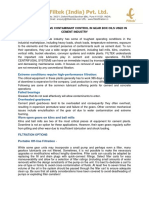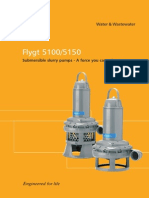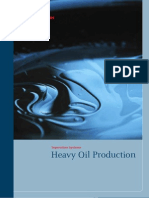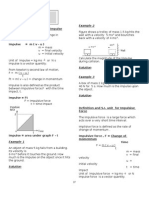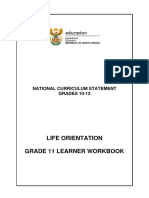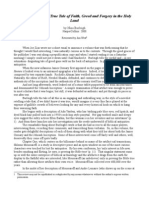Mifab Interceptor PDF
Mifab Interceptor PDF
Uploaded by
Bashir SaadehCopyright:
Available Formats
Mifab Interceptor PDF
Mifab Interceptor PDF
Uploaded by
Bashir SaadehOriginal Title
Copyright
Available Formats
Share this document
Did you find this document useful?
Is this content inappropriate?
Copyright:
Available Formats
Mifab Interceptor PDF
Mifab Interceptor PDF
Uploaded by
Bashir SaadehCopyright:
Available Formats
MIFAB INTERCEPTOR SELECTION GUIDE
There are three main types of interceptors: grease, oil and solids. Each of them requires different
considerations for sizing, operation and maintenance. The information provided will help the specifier select the
correct interceptor for the application. A detailed explanation of the major components and features of each
type of interceptor is also provided.
Grease Interceptors
Grease, which also includes fats and oils, has historically caused problems in plumbing drainage systems.
Grease easily adheres to the inner surface of most commonly used drainage piping material and over time will
form into a hard crust as tough as baked clay. The rougher the inner surface of the pipe, the easier this
adherence will occur. Grease is also a problem for sewage treatment plants as it taxes the bacterial process
used to break down these complex compounds.
The purpose of a grease interceptor is to trap and store the suspended grease from the water passing through
it. They are usually connected to kitchen sinks, floor drains, and any other plumbing fixtures in restaurants,
hotels and institutions that discharge grease laden waste water. MIFAB's grease interceptors operate on the
principle of separation by flotation.
As our environmental laws have become more restrictive and maintenance costs have increased, public sewer
departments have responded by tightening the list of materials allowed to flow into their systems. Severe fines
may be levied on those users found to be in violation. Grease that is removed from the drainage system as
close as possible to its source and before it becomes contaminated with other material, can be sold to
rendering companies and recycled into a variety of products. It can therefore become an economic asset rather
than liability.
The specifying engineer should consider the following when specifying grease interceptors: construction /
operation, flow control fitting, extensions, cover shrouds and draw-off valves, sizing, installation and
maintenance.
Construction / Operation
All of MIFAB's grease, oil and solids interceptors are manufactured with 10 gage hot rolled steel that is welded
together and coated with an electro-statically applied baked epoxy finish. The cover sealing gasket is
manufactured with low durometer closed-cell neoprene with self-adhesive backing. The gasket is custom fitted
to the interceptor body top rim ledge where it is an integral part of the body. Because of the gasket's thickness
and density, it provides an ideal sealing environment for the lid. All of MIFAB's interceptors are supplied with the
same gasket. All grease interceptors are supplied with a baffle system engineered to improve the grease/oil
separation process. The baffle system is strategically located to direct inflow for maximum efficiency of the
interceptor. Flow entering the interceptor is directed to the bottom by the baffle to avoid any disturbance of the
previously accumulated surface layer of grease / oil in the device. The baffle also serves to reduce the velocity
and surge of inflow, providing sufficient retention time for effective separation of the grease. The grease rises to
the surface for manual or draw-off removal and the baffle is easy to remove for cleaning. The waste water is
now relieved of over 90% of the fats, oils and greases and continues to flow through the interceptor into the
drainage system. Many MIFAB grease interceptors bear the PDI (Plumbing and Drainage Institute) seal. This
seal on MIFAB's grease interceptors proves that the designs and ratings marked on the interceptor have met or
surpassed all standards established by PDI. All of MIFABs PDI approved grease interceptors are supplied with
external, vented flow control fittings to ensure maximum performance. A detailed description of flow control
fittings is on page ii.
MIFABs factory is certified to the ISO 9001-94 Design and Manufacturing Standard. Design and dimensions are subject to modification.
i
MIFAB FLOW CONTROL FITTING GUIDE
FLOW CONTROL FITTING APPLICATION: Flow control fittings are furnished at no extra cost with all MIFAB MI-G, MIG-L, MI-G-SD MI-G-SDH and MI-G-L-SDH grease interceptors. They are essential to achieve maximum efficiency.
FLOW CONTROL FITTING DESCRIPTION: Flow control fittings insure 90% or more grease retention efficiency of the
interceptor. When consideration isnt given to the flow rate of the waste water to be handled, the actual flow rate through the
interceptor usually exceeds its rated maximum. With such flow rate, the interceptor would be overloaded. Retention time within
the unit would not be sufficient for maximum separation. The result would be low efficiency, and pollutants left in the waste
water would pass through the interceptor, making the installation less than effective. When the flow is controlled by use of a
MIFAB flow control fitting so that it can never exceed the maximum rating of the interceptor, and the interceptor is cleaned on
a regular basis, the maximum pollutant retention efficiency will be achieved and maintained.
All flow control fittings are built with an air intake and should be connected to the vent stack or vent not lower than the flow
level of the highest drain serviced or terminated in a return bend at the same elevation outside of the building. A vented flow
control fitting improves the efficiency of the grease interceptor by introducing air into the body of the interceptor. As the air
bubbles rise to the surface, they are coated with grease. This process brings grease to the surface faster, and, as a result,
increases the efficiency.
2-1/2
(64)
2 (50)
2 = 4 (100)
3 = 5 (125)
4 = 6 (150)
7
(175)
FLC
FLC-T
(DIMENSION) DENOTES MILLIMETRES
FOR USE WITH NO HUB PIPE
MODEL
MIFAB
CONNECTION
NO. INTERCEPTOR
SIZE
FLC-0
MI-G-0
2 (50)
FLC-1
MI-G-1
2 (50)
FLC-2
MI-G-2
2 (50)
FLC-3
MI-G-3
2 (50)
FLC-4
MI-G-4
3 (75)
FLC-5
MI-G-5
3 (75)
FLC-6
MI-G-6
3 (75)
FLC-7
MI-G-7
3 (75)
VENT
ORFICE CONNECTION
SIZE
SIZE
.375 (9)
2 (50)
.500 (13)
2 (50)
.656 (16)
2 (50)
.750 (19)
2 (50)
1.000 (25)
2 (50)
1.250 (31)
2 (50)
1.250 (31)
2 (50)
2.000 (50)
2 (50)
FOR USE WITH I.P.S PIPE
VENT
MODEL
MIFAB
CONNECTION
ORFICE CONNECTION
NO. INTERCEPTOR
SIZE
SIZE
SIZE
FLC-T-0
MI-G-0
2 (50)
.375 (9)
2 (50)
FLC-T-1
MI-G-1
2 (50)
.500 (13)
2 (50)
FLC-T-2
MI-G-2
2 (50)
.656 (16)
2 (50)
FLC-T-3
MI-G-3
2 (50)
.750 (19)
2 (50)
FLC-T-4
MI-G-4
3 (75)
1.000 (25)
2 (50)
FLC-T-5
MI-G-5
3 (75)
1.250 (31)
2 (50)
FLC-T-6
MI-G-6
3 (75)
1.250 (31)
2 (50)
FLC-T-7
MI-G-7
3 (75)
2.000 (50)
2 (50)
MIFABs factory is certified to the ISO 9001-94 Design and Manufacturing Standard. Design and dimensions are subject to modification.
ii
MIFAB INTERCEPTOR SELECTION GUIDE
(Contd)
Extensions
Extensions should be specified on grease and oil interceptors when the interceptor is buried into the ground,
vertical adjustment of the interceptor is necessary to meet the drainage piping, and/or floor level access is
required. Extension heights range from four inches to any maximum practical for serviceability. Extensions in
excess of 20" are not recommended. One must consider the slope of the drainage piping from the fixtures to
the inlet of the interceptor. Typically, one should allow a slope of " per foot in the drainage pipe. Therefore,
there will be many installations, especially with large interceptors, where the sloped drainage pipe ends up
below the inlet connection. An extension is added to the top of the interceptor so that the inlet can be lowered
to meet the incoming drainage pipe and the lid of the interceptor can be extended to floor level. MIFAB offers
three different kinds of extensions: integral, bolt on and cover shrouds. An integral extension is specified by
expanding the "C" dimension on the interceptor. The "C" dimension is from the middle of the inlet and outlet to
the top of the interceptor. One would specify a "C" dimension to meet the job requirements and the interceptor
will be manufactured to that specification. The extension is incorporated into the production of the interceptor to
produce a seamless, integral interceptor. A second method of providing an extension is a bolt on design. In this
example, a top is manufactured out of the same material as the body. The extension is secured to the body by
means of "C lock" devices bearing against its base flange, compressing the sealing gasket to complete the
union. The regular lid is bolted to the extension top in the same manner as it would be to the body of a
standard interceptor.
Cover Shrouds
In installations where the exact extension dimension required is unknown or where little notice has been
provided to the installer advising of the need for an extension; integral and bolt on extensions are impractical
due to the time necessary for their fabrication. MIFAB's nationwide network of manufacturer's representatives
stock cover shrouds for immediate shipment to jobsites when these situations occur. The cover shroud is
adjustable and is recessed into the slab to house the interceptor. Cover shrouds incorporate either standard or
draw-off grease interceptors mounted on adjustable elevation cradles in either open or closed bottom housings
with non-skid floor level lids. Cover shrouds are particularly important where below floor level installation of
draw-off grease interceptors is required, because such models cannot be installed independently with tops at
the finished floor level. Specify MIFAB MI-CS Series for use with the MI-G Series grease interceptors and MIFAB
MI-CSD Series for use with the MI-G-SD and MI-G-SDH semi-automatic draw off grease interceptors.
(MI-CS COVER SHROUD
ILLUSTRATED)
MIFABs factory is certified to the ISO 9001-94 Design and Manufacturing Standard. Design and dimensions are subject to modification.
iii
MIFAB INTERCEPTOR SELECTION GUIDE
(Contd)
Draw-off valve
All of MIFAB's semi-automatic grease interceptors are manufactured with draw-off valves and are preferred in
areas where excessive amounts of grease accumulates because they make the cleaning process easier. The
draw-off valve is a gate valve that is connected to the outlet of the interceptor via a pipe nipple. When the
accumulated grease is ready to be drawn off, the pipe cap on the top of the interceptor is removed and the
draw-off hose is attached with a hose clamp. After warming the interceptor with hot water from the fixture to
liquefy the accumulated grease, the draw-off valve is closed to block water escaping through the outlet. Water
from the fixture enters at a low flow rate to elevate the liquefied grease into the draw-off pyramid and through
the hose to the disposal container. When clear water appears at the hose outlet, the draw-off valve is opened to
drop the water level in the interceptor for normal operation. This method of cleaning is more sanitary that the
typical manual method. Specify MIFAB Series MI-G-SD, MI-G-SDH and MI-G-L-SDH Series of semi-automatic
grease interceptors.
(MI-G-SDH SEMI-AUTOMATIC GREASE INTERCEPTOR ILLUSTRATED)
MIFABs factory is certified to the ISO 9001-94 Design and Manufacturing Standard. Design and dimensions are subject to modification.
iv
MIFAB GREASE INTERCEPTOR SIZING GUIDE
Sizing
Reliable performance of any grease interceptor is dependant on its being correctly sized to handle the
anticipated drainage load from the fixtures it serves. Each MIFAB interceptor is flow and capacity rated for easy
selection when sizing requirements have been established and met. Sizing is based on fixture drainage period,
service required and volume of wastewater to be handled. These factors combine to establish the anticipated
flow rate and the size of the interceptor required. The flow control fitting that is provided with every MIFAB
grease interceptor sized 50 GPM and smaller, is installed in the fixture drain line ahead of the interceptor and
controls the flow of drainage to the interceptor's rated capacity. This is especially important when the drainage
load exceeds that for which the interceptor is sized to handle. The following sizing formula is based on the
P.D.I. G-101 (Plumbing and Drainage Institute) requirements:
1. Calculate the volume in cubic inches of all the fixtures to be served by the Grease Interceptor. (length x
width x depth = capacity)
2. * Eg: 15 x 24 x 10 = 3600 cubic inches. Since a three compartment sink is serving the grease
interceptor, multiply the single compartment cubic inch capacity by three to obtain the total capacity in
cubic inches. (10,800 in2). Divide this number by 231 to convert the volume to US gallons. * Eg: Cubic
capacity of 10,800 in2231=46.75 gallons; multiplied by 75% = 35.06 U.S.G. Use MIFAB model number
MI-G-6 which has a rated flow capacity of 35 G.PM.
3. These capacities are based on a one minute drain-down time with the interceptor adjacent to the fixture(s).
If a two minute drain-down time is acceptable, then divide the capacity by two.
4. The flow control fitting, supplied with the interceptor, must be in position at all times. If this is removed, or
not provided, the interceptor will not function to P.D.I. standards.
5. If an interceptor is to be installed with the top level at the finished floor, an extension type may be required.
In that instance, the C dimension is required, (center line of inlet/outlet to top of the finished floor) and
must be specified at time of ordering.
Fixture Unit Sizing Method
The majority of plumbing codes list the drainage fixture-unit values for plumbing fixtures. For fixtures not listed,
the codes provide drainage fixture-unit values based on drain outlet or trap size. Drainage fixture-unit values
are converted to GPM discharge rates on the basis of one drainage fixture-unit equaling 7.5 GPM fixture
discharge rate. The drainage fixture-unit sizing for grease interceptors is included for those that prefer this
approach as an alternative to the conventional (volume) sizing. The following table provides the suggested PDI
size grease interceptor based on drainage fixture-unit sizing method.
Fixture
Outlet or trap
Size (inches)
Drainage
Fixture-unit
Value
GPM
Discharge
Equivalent
Suggested
GPM Flow Rate
Interceptor
MIFAB
Model
Number
1 "
1 "
2"
2 "
3"
4"
1
2
3
4
5
6
7.5
15.0
22.0
30.0
37.5
45.0
10
15
25
35
50
50
MI-G-2
MI-G-3
MI-G-5
MI-G-6
MI-G-7
MI-G-7
The following factors may require an increase in the size of the grease interceptor: location, presence of
detergents in the waste water, ratio of grease to water, specific gravity weight of the grease filtrates, speed of
incoming water flow, presence of large particles mixed with the grease laden water, and percentage of
maximum flow capacity. The interceptor should be installed as close as possible to the source of grease to
prevent pipes draining into the grease interceptor from becoming clogged as grease-laden water cools before
entering the grease interceptor. Grease cutting detergents will break the liquid grease into tiny particles and
cause them to pass through the interceptor. The higher the ratio of grease particles to water the lower the
efficiency of the interceptor. Grease with a lower gravity will rise to the surface much faster than grease particles
with a higher gravity which will remain near the bottom of the interceptor, taking a greater amount of time to
float to the surface, or not to the surface at all. The faster the incoming waste water, the more turbulent the
grease laden water will be when it enters the interceptor. This will slow the separation process and therefore,
the efficiency. Solids and particles such as bits of food permitted entry into the interceptor will attract adhesion
of the grease particles. This will reduce the efficiency of the grease interceptor. If the incoming flow from the
fixtures is greater than the rated capacity of the interceptor, the efficiency of the interceptor will decrease
considerably.
MIFABs factory is certified to the ISO 9001-94 Design and Manufacturing Standard. Design and dimensions are subject to modification.
v
MIFAB GREASE INTERCEPTOR
INSTALLATION AND MAINTENANCE GUIDE
Installation Diagrams
Figures A2.5.1 through A2.5.5 are included to
illustrate various grease interceptor installations normally encountered in domestic,
commercial and institutional systems. These
figures will serve as a guide to practical
application of grease interceptors.
Fig. A2.5.1 Interceptor Serving Trapped and Vented
Sink - Flow Control Air Intake Intersects Vent
Fig. A2.5.2 Interceptor Serving Sink - Flow Control Air
Intake Terminates in a Return Bend Above Flood Level
INSTALLATION CONSIDERATIONS
Install interceptor as close as practical to fixture or fixtures being served,
see figures A2.5.1 through A2.5.5. The interceptor may be set on the floor,
partially recessed in the floor, with top flush with the floor, or fully recessed
below the floor to suit piping and structural conditions.
Anticipate sufficient clearance for removal of interceptor cover for cleaning.
Avoid installation wherein long runs of pipe (exceeding 25 feet (7500)) are
necessary to reach interceptor. This precaution will preclude the possibility
of pipeline becoming clogged with congealed grease that will collect before
reaching the grease interceptor.
Do not install grease interceptor in waste line from garbage grinder.
Garbage grinder waste must by-pass interceptor, for rapid accumulation of
solid matter will greatly reduce grease interceptor efficiency preventing
operation in compliance with rated capacity.
FLOW CONTROL
The flow control fitting furnished with PDI certified interceptors must be installed
ahead of interceptor in the waste line beyond the last connection from the fixture
and as close as possible to the underside of lowest fixture. When waste of two or
more sinks or fixtures are combined to be served by one interceptor, a single flow
control fitting should be used. Air intake for flow control may terminate under sink
drain board as high as possible to prevent overflow or terminate in a return bend
at the same height and on outside of building. When fixture is individually trapped
and back-vented, air intake may intersect vent stack. All installation
recommendations subject to approval of code authority.
VENTING
Grease interceptors must have a vented waste, sized in accordance with code
requirements for venting traps to retain water seal and prevent siphoning.
Fig. A2.5.3 Interceptor Serving Dishwasher - Flow
Control Air Intake Terminates Above Flood Level
MULTIPLE FIXTURE INSTALLATION
One interceptor to serve multiple fixtures is recommended only where fixtures are
located close together. In such installations, each fixture should be individually
trapped and back-vented.
MAINTENANCE
Fig. A2.5.4 Interceptor Serving Two Individually
Trapped and Vented Sinks - Flow Control Air Intake
Intersects Vent
GENERAL CONSIDERATIONS
To obtain optimum operating efficiency of a properly sized and installed PDI
certified grease interceptor, a regular schedule of maintenance must be adhered
to. All PDI certified grease interceptors are furnished with manufacturers
operating and maintenance instructions, which must be followed to insure
efficient satisfactory operation.
CLEANING
All grease interceptors must be cleaned regularly. The frequency of grease
removal is dependent upon the capacity of the interceptor and the quantity of
grease in the waste water. Grease removal intervals may therefore vary from once
a week to once in several weeks. When the grease removal interval has been
determined for a specific installation, regular cleaning at that interval is necessary
to maintain the rated efficiency of the interceptor. After the accumulated grease
and waste material has been removed, the interceptor should be thoroughly
checked to make certain that inlet, outlet and air relief ports are clear of
obstructions.
DISPOSITION OF INTERCEPTED MATERIALS
Grease and other waste matter that has been removed from the interceptor
should not be introduced into any drain, sewer, or natural body of water. This
waste matter should be placed in proper containers for disposal. Where recovery
of grease is desired, it can be handled in a manner suitable to the authorities.
Fig. A2.5.5 Interceptor Serving Trapped and Vented
Sinks - Flow Control Air Intakes Intersect Vent
MIFABs factory is certified to the ISO 9001-94 Design and Manufacturing Standard. Design and dimensions are subject to modification.
vi
MIFAB INTERCEPTOR SELECTION GUIDE
(Contd)
Dishwashers
A separate grease interceptor is recommended for each commercial dishwasher. The size of the interceptor is
determined by the GPM discharge rate of the dishwasher as specified by the manufacturer.
Floor Drains
Many local plumbing inspectors require that grease laden wastewater flowing into floor drains must flow
through a grease interceptor before draining into the sanitary sewer system. In these instances, the flow control
fitting must be installed underground, before the inlet to the interceptor, to moderate the flow from the floor
drains and to ensure maximum performance. Consideration should be given to providing access to the flow
control fitting in these installations for proper cleaning and maintenance. The MIFAB MI-CSD extended cover
shroud is best used in these situations because it is long enough to house the grease interceptor and the flow
control fitting beside the inlet. A hole can be cut into the lid of the cover shroud to allow the vent piping to
connect to the top of the flow control fitting.
Solids interceptors
The interception and retention of solids cannot be overlooked. Materials such as lint, hair, grindings, ceramic
waste, plaster, dental wastes, aquarium and other small gravel, jewels and precious metals are a few solids that
should pass through a solids interceptor before entering the waste drain line. Deleterious solids should be
intercepted to prevent clogging of the drainage lines and valuable materials require interception for retrieval.
MIFAB manufactures a complete line of solids interceptors designed to handle any waterborne solids. Most
often these interceptors replace the standard traps of the fixtures they serve. The solids interceptor with a low
inlet and high outlet becomes the fixture trap. Solids interceptors are manufactured with easily removable
strainers or sediment baskets that serve to retain the intercepted solids while allowing water to flow through. It
is good engineering practice to specify a solids interceptor immediately before a grease interceptor so that all
debris and solid wastes are caught in the solids interceptor before they enter the grease interceptor. This will
ensure that the grease interceptor is not filled as quickly with solid wastes that will only impair its efficiency. In
addition, most foul odors from grease interceptors are from rotting solids, not from the grease itself. Proper
separation of these solids will reduce the odor problem typically experienced with grease interceptors filled with
rotting solids. See MIFAB's MI-SOLID, MI-LINT, MI-HAIR and MI-FISH Series of solids interceptors.
(MI-SOLID-M ILLUSTRATED)
MIFABs factory is certified to the ISO 9001-94 Design and Manufacturing Standard. Design and dimensions are subject to modification.
vii
MIFAB OIL INTERCEPTOR SELECTION GUIDE
APPLICATION:
MIFAB oil interceptors are designed for use in drain lines where oils, sediment and other volatile liquids are found. These
drain lines may be from areas in parking garages, machine shops, service stations, aircraft hangars, industrial and
manufacturing facilities.
DESIGN:
MIFAB oil interceptors are designed to protect against water pollution by preventing oils and sediment in waste water from
entering drain lines. The design allows intercepted oils to be drawn-off automatically for storage continuously during
operation. Sediment should be removed from the interceptor at regular intervals.
SIZING:
1. Determine maximum volume of waste water in G.P.M. or L.P.M., by summing volumes of all discharging fixtures that may
enter the drain lines at one time.
Plumbing and Drainage
Mechanical Section
2. Select oil interceptor with flow rating equal to peak volume in G.P.M. or L.P.M. (see table on shop drawing.) Provide storage
tank capable of handling the volume.
TYPICAL CODE REGULATIONS
Vehicle servicing. When an oil interceptor is installed in an automobile, truck, bus, or tractor garage or in a service station
or repair shop with facilities for motor or transmission overhauling, it must have a minimum static water depth of 24 inches
(600) below the invert of the interceptor outlet and a minimum static water capacity of 6 cubic feet.
This regulation applies to facilities where not more than three vehicles are serviced. For each additional vehicle up to and
including ten, 1 cubic foot of static capacity shall be added. For each vehicle over ten, an additional 0.25 cubic foot shall be
added.
Vehicle storage and servicing. Where motor vehicles are serviced and stored, an oil interceptor shall be installed with a
static water capacity of 1 cubic foot for every 100 square feet of area to be drained. The oil interceptor shall have a minimum
static water level of 6 cubic feet.
Mechanical car washing. In facilities designed especially for mechanical washing of motor vehicles, a sand and gravel
interceptor shall be installed to receive the waste water from all washing facilities. A minimum static water level of 2.5 feet
and a minimum static water capacity of 50 cubic feet shall be maintained.
Where motor cleaning services are rendered at mechanical car washing facilities, an oil interceptor shall be installed in that
section of the drainage system which receives waste water from this operation.
Vehicle storage. In motor vehicle storage facilities, a combination interceptor-drain shall be installed with a static water level
of 1 gallon for every 100 square feet of area to be drained.
Manual car washing. In a one-car washing facility, a combination interceptor-drain shall be installed with a minimum static
water capacity of 30 gallons.
OIL DRAW-OFF
Oil draw-off funnel is adjustable to
the gravity height of oil and gallon
per minute flow. It leads in to oil
discharge pipe, from which
suitable disposal of oil can be
made in the most economical
way.
After interceptor is installed,
establish operating water level by
running water through interceptor
at maximum flow rate expected.
Adjust vertical draw-off pipe 1/8
(3) to 1/4 (6) above water line.
Periodic checking of this level
after interceptor is in operation will
assure proper functioning of the
oil draw-off. If drawn off oil
contains any water, raise vertical
draw-off pipe until only oil flows
from interceptor.
GRAVITY OIL DRAW-OFF
DRAW-OFF CONNECTIONS
Connect to Holding Tank which must be vented
(Dimension) Denotes Millimetres
MIFABs factory is certified to the ISO 9001-94 Design and Manufacturing Standard. Design and dimensions are subject to modification.
viii
You might also like
- Hibon Tri Lobe Blower Manual PDFDocument55 pagesHibon Tri Lobe Blower Manual PDFtayyabeme100% (1)
- Cladding Fixing CalculationDocument26 pagesCladding Fixing Calculationcoolkaisy100% (1)
- 075 Oil Mist Application Manual PDFDocument34 pages075 Oil Mist Application Manual PDFAdolfo EirasNo ratings yet
- P300Document6 pagesP300abbas_mehdeNo ratings yet
- WindBack SealDocument2 pagesWindBack SealMongkonkehaChanachonNo ratings yet
- Bisoprolol in HypertensionDocument35 pagesBisoprolol in HypertensionjimNo ratings yet
- AlliterationDocument4 pagesAlliterationapi-284232017No ratings yet
- Practical Experience With Oil Mist LubricationDocument8 pagesPractical Experience With Oil Mist Lubricationannccknarime100% (1)
- Jay R Smith Grease InterceptorsDocument6 pagesJay R Smith Grease InterceptorsonspsnonsNo ratings yet
- ZP CPS DS 0207Document2 pagesZP CPS DS 0207jmpandolfiNo ratings yet
- Howden - FFP Free Floating Piston Lowres PDFDocument4 pagesHowden - FFP Free Floating Piston Lowres PDFdigecaNo ratings yet
- Installation and Operating Procedures: Manual Grease InterceptorsDocument8 pagesInstallation and Operating Procedures: Manual Grease InterceptorsZoebairNo ratings yet
- Gear Box Oil Filtration in Cement Mills PDFDocument2 pagesGear Box Oil Filtration in Cement Mills PDFShirish Patwardhan100% (1)
- AMSOIL BMK30 - Heavy-Duty Remote By-Pass Filtration SystemDocument2 pagesAMSOIL BMK30 - Heavy-Duty Remote By-Pass Filtration SystemamsoildealerNo ratings yet
- Crank Case VentilationDocument0 pagesCrank Case VentilationAnoj pahathkumburaNo ratings yet
- Tilting Pad Thrust BearingDocument6 pagesTilting Pad Thrust BearingChristopher GarciaNo ratings yet
- 01 Chemical ProcessDocument333 pages01 Chemical ProcessDavid ValladaresNo ratings yet
- Z1170 EngineeredDocument4 pagesZ1170 EngineeredMahmoud GwailyNo ratings yet
- Update Your Oil Mist Lubrication KnowledgeDocument2 pagesUpdate Your Oil Mist Lubrication Knowledgehello17No ratings yet
- SD10Document4 pagesSD10samer tirhiNo ratings yet
- Turbo AirDocument20 pagesTurbo AirDavid SpinosoNo ratings yet
- 5100 5150 - 5000 SeriesDocument8 pages5100 5150 - 5000 SeriesFerpundo LaqueruchoNo ratings yet
- Tech PDFDocument3 pagesTech PDFAwais JalaliNo ratings yet
- TCL Training Day 2Document140 pagesTCL Training Day 2kixiliy439No ratings yet
- Technology: Machine Reliability. The Early YearsDocument7 pagesTechnology: Machine Reliability. The Early Yearsdaniel adamNo ratings yet
- API Separators - The Workhorse of Refinery Wastewater Treatment SystemsDocument8 pagesAPI Separators - The Workhorse of Refinery Wastewater Treatment SystemsAntoNo ratings yet
- Flowserve Multiphase PumpsDocument8 pagesFlowserve Multiphase PumpsveronrazvyNo ratings yet
- 2008 Filter and Fluid Application Guide2Document16 pages2008 Filter and Fluid Application Guide2KAPDSCNo ratings yet
- Psi Max2000 AgitatorsDocument167 pagesPsi Max2000 Agitatorssaipem880% (1)
- Gas Flotation SystemDocument2 pagesGas Flotation SystemJessika LópezNo ratings yet
- Hydraulic Oil Brochure EmailDocument4 pagesHydraulic Oil Brochure Emaildarl1No ratings yet
- API Separators Article SolutionsDocument8 pagesAPI Separators Article SolutionsRenalyn TorioNo ratings yet
- Flygt 5100-5150 PumpsDocument8 pagesFlygt 5100-5150 PumpsRobsBerto ManzanedaNo ratings yet
- Bestec Oil InterceptorsDocument6 pagesBestec Oil InterceptorsSai PrasathNo ratings yet
- Fabio Air SpringsDocument376 pagesFabio Air SpringsАлексей ПобережнюкNo ratings yet
- Constant-Level Oiler Installation and Maintenance TipsDocument6 pagesConstant-Level Oiler Installation and Maintenance TipsMarcosNo ratings yet
- Typhonix Low Shear Pump Brochure (1)Document10 pagesTyphonix Low Shear Pump Brochure (1)jafarNo ratings yet
- Troubleshooting Centrifugal Gas Compressor Shaft Oil SealsDocument33 pagesTroubleshooting Centrifugal Gas Compressor Shaft Oil SealsMuhammad afzal100% (1)
- Interceptors: S-WD-INTER-1 0812Document11 pagesInterceptors: S-WD-INTER-1 0812Athirah Amer HamzahNo ratings yet
- Compressor ManturboDocument6 pagesCompressor ManturboSubhasish MitraNo ratings yet
- Trico Watchdog Valintaohjeet EnglanniksiDocument5 pagesTrico Watchdog Valintaohjeet EnglanniksiDavid Alfonso CaraballoNo ratings yet
- Boletin Non ClogDocument12 pagesBoletin Non ClogulisesgeNo ratings yet
- Sotras ManualDocument24 pagesSotras ManualcivodulNo ratings yet
- Mitsubishi Centrifugal Compressor: MCO Web SiteDocument3 pagesMitsubishi Centrifugal Compressor: MCO Web SitePoliana PolyNo ratings yet
- Brochure - Oil Production & SeparationDocument8 pagesBrochure - Oil Production & SeparationAntHony K-ianNo ratings yet
- Plant Air CompressorDocument20 pagesPlant Air CompressorAndrei SavvaNo ratings yet
- Ge Dry Gas Seal RetrofitDocument4 pagesGe Dry Gas Seal RetrofitlubangjarumNo ratings yet
- FilsafDocument2 pagesFilsafAbdaljaleelAlqazeeNo ratings yet
- En Open Gear GBDocument12 pagesEn Open Gear GBArnaldo Macchi MillanNo ratings yet
- Transsmission Oil SystemDocument8 pagesTranssmission Oil Systemamin chaabenNo ratings yet
- Fleetguard - Understanding Engine Oil Contamination and FiltrationDocument4 pagesFleetguard - Understanding Engine Oil Contamination and Filtrationalfatih1407497No ratings yet
- Brembo Catalogo PDFDocument116 pagesBrembo Catalogo PDFtd04gigs100% (1)
- Air Changes Per HourDocument28 pagesAir Changes Per Hourkunanto kunantoNo ratings yet
- Grease Trap Installation Operation Maintenance PDFDocument5 pagesGrease Trap Installation Operation Maintenance PDFfrankcysNo ratings yet
- CC30 Manual (Mangueras)Document12 pagesCC30 Manual (Mangueras)eduardoagueroNo ratings yet
- Can Plas Grease Interceptor.113577Document8 pagesCan Plas Grease Interceptor.113577Rheymar BarcalaNo ratings yet
- Thruster Oil Contaminated With Water CJC 261011Document7 pagesThruster Oil Contaminated With Water CJC 261011Nguyen Dang HaNo ratings yet
- Filtration With Offline Oil Filters SDN Rev Feb 2013 01 PDFDocument7 pagesFiltration With Offline Oil Filters SDN Rev Feb 2013 01 PDFLatifahabubakar EifaNo ratings yet
- FV Non CloggingVerticalCentileverSumpPump E10117Document2 pagesFV Non CloggingVerticalCentileverSumpPump E10117Alejandro VegaNo ratings yet
- DB DISA FLEX LowresDocument8 pagesDB DISA FLEX LowresdfeltrinpNo ratings yet
- A DIY'ers Definitive Guide to Building a Custom Volkswagen TrikeFrom EverandA DIY'ers Definitive Guide to Building a Custom Volkswagen TrikeNo ratings yet
- Installation and Operation Instructions For Custom Mark III CP Series Oil Fired UnitFrom EverandInstallation and Operation Instructions For Custom Mark III CP Series Oil Fired UnitNo ratings yet
- Population Materials Use Econo.v11Document5 pagesPopulation Materials Use Econo.v11eumi jane maskarinoNo ratings yet
- Electrorheological Fluid - Wikipedia, The Free EncyclopediaDocument4 pagesElectrorheological Fluid - Wikipedia, The Free EncyclopediaSundae bgramNo ratings yet
- BlackbirdDocument4 pagesBlackbirdorigamibooksNo ratings yet
- Quantitative Analysis For Management Decisions (MBA 662)Document50 pagesQuantitative Analysis For Management Decisions (MBA 662)Tsehayou SieleyNo ratings yet
- Carlos L. Albert High School: LITERATURE REVIEW Online Game AddictionDocument5 pagesCarlos L. Albert High School: LITERATURE REVIEW Online Game AddictionNeo Jhene Ann RafolNo ratings yet
- Flusarc Compact CBCC Technical Data SheetDocument6 pagesFlusarc Compact CBCC Technical Data SheetYalem Alemayehu100% (1)
- The Myth of ExperienceDocument1 pageThe Myth of Experiencejavierstudent05No ratings yet
- Case Study - Platinum - Hyundai Accent 2016 1.6L V1Document2 pagesCase Study - Platinum - Hyundai Accent 2016 1.6L V1quỳnh trầnNo ratings yet
- SDO Quezon IRI Oath of ConfidentialityDocument1 pageSDO Quezon IRI Oath of ConfidentialityMark Patrics Comentan Verdera100% (1)
- Chp2 Taxonomy SW MaintaineanceDocument7 pagesChp2 Taxonomy SW MaintaineanceTooba AkhterNo ratings yet
- Charles Steinmetz Letter Book 17 December 1913 May 1914Document17 pagesCharles Steinmetz Letter Book 17 December 1913 May 1914NarasimNo ratings yet
- 2 Sa 970Document4 pages2 Sa 970AlexandreMdeSouzaNo ratings yet
- L1 Solution Deck For SAP S4 HANA RetailDocument17 pagesL1 Solution Deck For SAP S4 HANA RetailbupeshNo ratings yet
- InfertilityDocument36 pagesInfertilityAakanksha PrassanaNo ratings yet
- Saxofon en AlemaniaDocument132 pagesSaxofon en AlemaniaLaura PinnaNo ratings yet
- A Report On Analysis On Report of Escorts Limited (Escorts)Document11 pagesA Report On Analysis On Report of Escorts Limited (Escorts)Sibika GadiaNo ratings yet
- Vacuum Excavator Truck DesignDocument8 pagesVacuum Excavator Truck Designajcapetillog100% (1)
- Theory of Organizational Culture and EffectivenessDocument21 pagesTheory of Organizational Culture and Effectivenessmwananzambi1850No ratings yet
- Chinese RevolutionDocument3 pagesChinese Revolutionhard02No ratings yet
- LESSON 2.6. Impulse, Impulsive Force and SafetyDocument7 pagesLESSON 2.6. Impulse, Impulsive Force and Safetychekgu_2007No ratings yet
- Bie South Africa Grade 11Document77 pagesBie South Africa Grade 11froggie :DNo ratings yet
- Automatic ControlDocument16 pagesAutomatic ControlSayed NagyNo ratings yet
- MODERATE Intensity To VIGOROUS IntensityDocument11 pagesMODERATE Intensity To VIGOROUS IntensityJohn michael puig100% (1)
- Physics June 2022 QPDocument28 pagesPhysics June 2022 QPCharlesNo ratings yet
- Calorimetry Lab 2Document5 pagesCalorimetry Lab 2wevsfirsttryNo ratings yet
- Overhaul: - Vane Pump AssyDocument7 pagesOverhaul: - Vane Pump AssyRomy MNo ratings yet
- Burleigh 2Document3 pagesBurleigh 2Jim WestNo ratings yet












